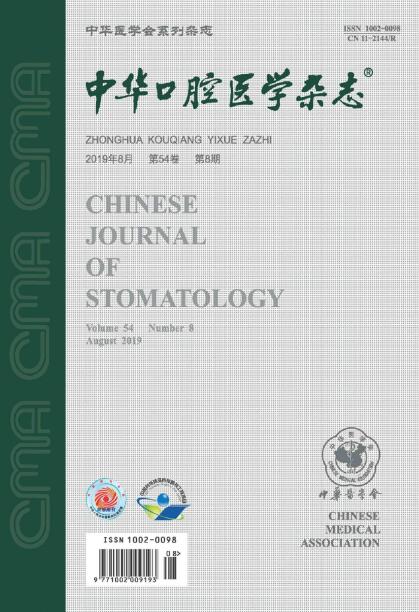[线粒体转移有助于牙间充质干细胞的成牙分化]。
摘要
目的研究牙科间充质干细胞(MSCs)中是否存在线粒体转移及其对牙本质分化的意义。方法:流式细胞术和免疫组化采用流式细胞术和免疫组化染色法分离牙间质干细胞。应用免疫荧光染色和活细胞成像技术确定牙科间充质干细胞中是否存在线粒体转移。从基因表达总库(GEO)数据库中重新分析了人类牙髓干细胞(DPSCs)和骨髓间充质干细胞(BMSCs)的转录组测序数据,证明了线粒体转移在牙科间充质干细胞中的重要性。用线粒体转移抑制剂 ML141 处理细胞,以二甲亚砜作为对照。免疫荧光染色、衰老相关β-半乳糖苷酶(SA-β-gal)染色、活性氧(ROS)检测、5-乙炔基-2'-脱氧尿苷(Edu)标记、细胞计数试剂盒-8(CCK-8)检测、Western 印迹、利用活细胞成像和透射电子显微镜分别研究了细胞形态、ROS 水平、细胞衰老、细胞增殖、间充质干细胞标志物配对相关同工酶 1(Prrx1)和 Sp7 转录因子(Sp7)表达、线粒体转移和线粒体形态。此外,在诱导牙本质分化过程中使用 ML141 后,使用碱性磷酸酶(ALP)显色试剂盒检测 ALP 活性,并使用实时荧光定量 PCR(RT-qPCR)检测牙本质分化相关基因 Alp、Sp7、牙本质基质蛋白 1(Dmp1)和牙本质唾液磷蛋白(Dspp)的表达,从而研究线粒体转移对牙本质分化的影响。结果牙间充质干细胞之间存在用 F-肌动蛋白标记的超细隧道纳米管(TNTs)结构,该结构中也证实存在转移线粒体。转录组测序数据表明,DPSCs 和 BMSCs 的基因表达谱存在显著差异。与 BMSCs 相比,DPSCs 中与线粒体转移和线粒体动态相关的基因明显增加。与对照组相比,线粒体转移抑制剂 1、5、10 μmol/L ML141 对细胞形态、细胞骨架和 ROS 水平的影响不大。ML141处理组的SA-β-gal活性和SA-β-gal阳性细胞比例[(3.93±0.21)%、(3.23±0.42)%、(4.06±0.84)%]与对照组[(3.83±0.28)%]无显著差异(均P>0.05)。在细胞增殖检测中,ML141处理组的EdU阳性细胞比例[(20.00±3.82)%、(19.48±1.96)%、(12.55±2.86)%]与对照组[(18.57±0.87)%]无显著差异(均P>0.05),而CCK-8检测结果显示,ML141处理1、5 μmol/L组的结果相似,均P>0.05。Western 印迹结果显示,ML141 处理组 PRRX1 和 SP7 蛋白表达水平与对照组无显著差异。活细胞成像结果显示,与对照组[(31.42±4.01)%]相比,ML141处理组的TNTs比例和线粒体转移[(13.45±1.46)%、(10.36±3.47)%、(9.32±1.11)%]在牙科间充质干细胞中明显降低(所有PPConclusions:牙科间充质干细胞之间存在线粒体转移,抑制线粒体转移会影响牙源性分化。Objective: To investigate whether there is mitochondrial transfer in dental mesenchymal stem cells (MSCs) and its significance for the odontogenic differentiation. Methods: Flow cytometry and immunohistochemical staining were used to isolate dental mesenchymal stem cells. Immunofluorescence staining and live cell imaging were applied to determine whether there is mitochondrial transfer in dental MSCs. Transcriptome sequencing data re-analysis of human dental pulp stem cells (DPSCs) and bone marrow mesenchymal stem cells (BMSCs) from gene expression omnibus (GEO) data base demonstrated the importance of mitochondrial transfer in dental MSCs. Cells were managed with mitochondrial transfer inhibitor ML141 with dimethyl sulfoxide as the control. Immunofluorescence staining, senescence-associated β-galactosidase (SA-β-gal) staining, reactive oxygen species (ROS) assay, 5-ethynyl-2'-deoxyuridine(EdU) labelling, cell counting kit-8 (CCK-8) assay, Western blotting, live cell imaging and transmission electron microscope were used to investigate cell morphology, ROS level, cellular senescence, cell proliferation, MSCs marker paired related homeobox 1 (Prrx1) and Sp7 transcription factor (Sp7) expression, mitochondrial transfer and mitochondrial morphology, respectively. Further, after using ML141 during the induction of odontogenic differentiation, alkaline phosphatase (ALP) chromogenic kit was used to detect ALP activity and real-time fluorescence quantitative PCR (RT-qPCR) was used to detect the expression of odontogenic differentiation-related genes Alp, Sp7, dentin matrix protein 1 (Dmp1), and dentin salivary phosphoprotein (Dspp), which were applied to investigate the effect of mitochondrial transfer on odontogenic differentiation. Results: An ultrafine tunneling nanotubes (TNTs) structure labelled with F-actin existed between dental MSCs, and the presence of transferring mitochondria in this structure was also confirmed. Transcriptome sequencing data suggested that the gene expression profiles were significantly different between DPSCs and BMSCs. Genes related to mitochondrial transfer and mitochondrial dynamic were significantly increased in DPSCs compared to BMSCs. Compared with the control group, treatment with 1, 5, 10 μmol/L ML141, the mitochondrial transfer inhibitor, had little significant effects on the cell morphology, cytoskeleton and ROS level. SA-β-gal activity and the proportion of SA-β-gal positive cells in the ML141-treated groups [(3.93±0.21)%, (3.23±0.42)%, (4.06±0.84)%] had no significant differences with the control group [(3.83±0.28)%] (all P>0.05). In the cell proliferation assay, the proportion of EdU positive cells in the ML141-treated groups [(20.00±3.82)%, (19.48±1.96)%, (12.55±2.86)%] had no significant differences (all P>0.05) with the control group [(18.57±0.87)%], whereas the CCK-8 assay showed similar results in ML141-treated group of 1, 5 μmol/L (all P>0.05). Western blotting results showed that the protein expression levels of PRRX1 and SP7 in the ML141-treated group had no significant differences with the control group. Live cell imaging showed that compared with the control group [(31.42±4.01)%], the proportion of TNTs and mitochondrial transfer in the ML141-treated groups [(13.45±1.46)%, (10.36±3.47)%, (9.32±1.11)%] were significantly decreased in dental MSCs (all P<0.001). Scanning electron microscope showed that the mitochondrial morphology of dental MSCs in the ML141-treated group was similar to the control group, with globular and short-rod shape. After 7 days of odontogenic differentiation, the ALP staining intensity of the ML141-treated group was significantly lower than the control group. After 21 days of induction, RT-qPCR results showed that compared with control group, the relative mRNA expressions of Alp, Sp7, Dmp1 and Dspp were significantly decreased in the ML141-treated group (all P<0.05), indicating that the suppression of mitochondrial transfer in dental MSCs inhibited the odontogenic differentiation. Conclusions: Mitochondrial transfer exists between dental MSCs, and inhibition of mitochondrial transfer impairs the odontogenic differentiation.

 求助内容:
求助内容: 应助结果提醒方式:
应助结果提醒方式:


